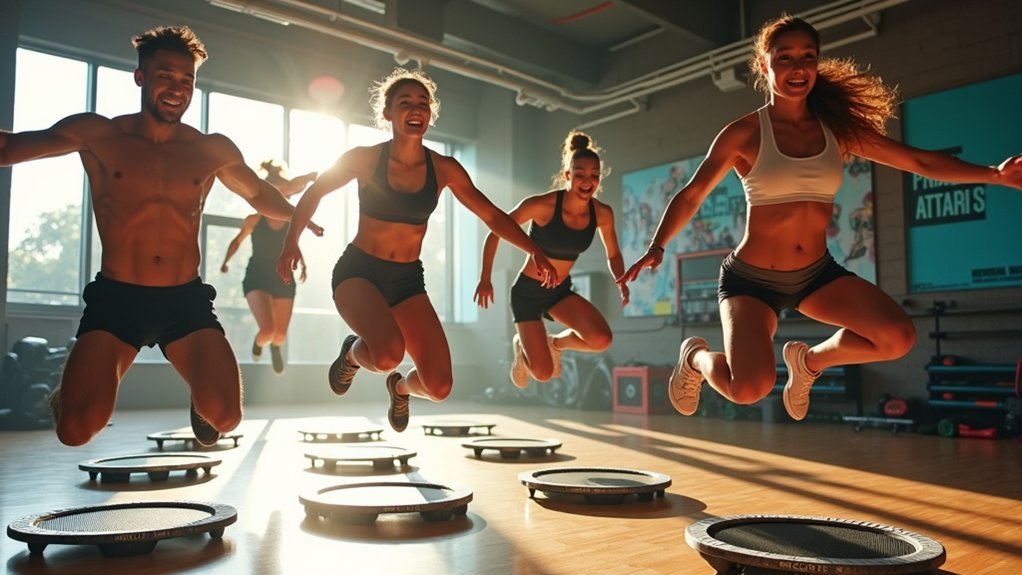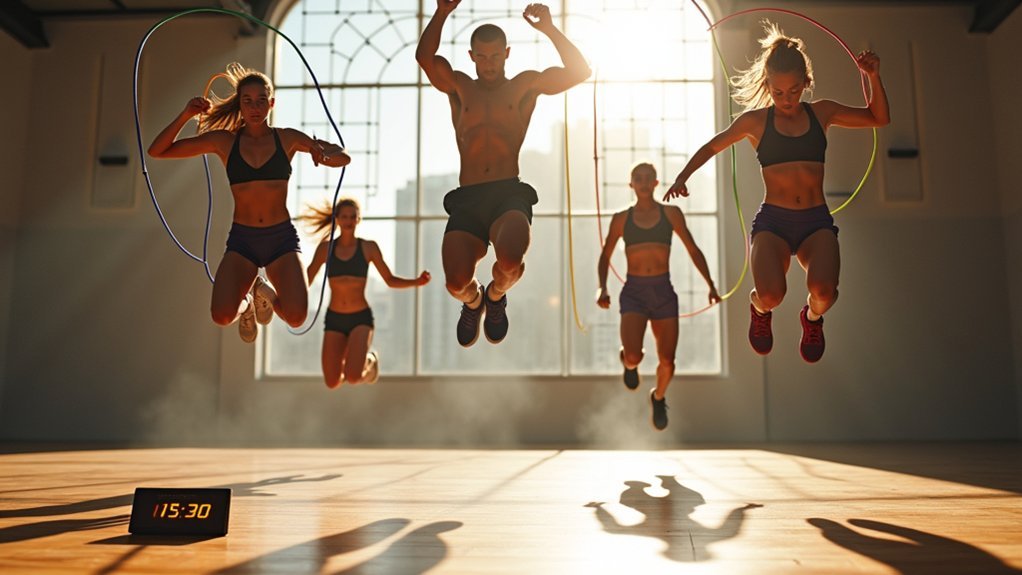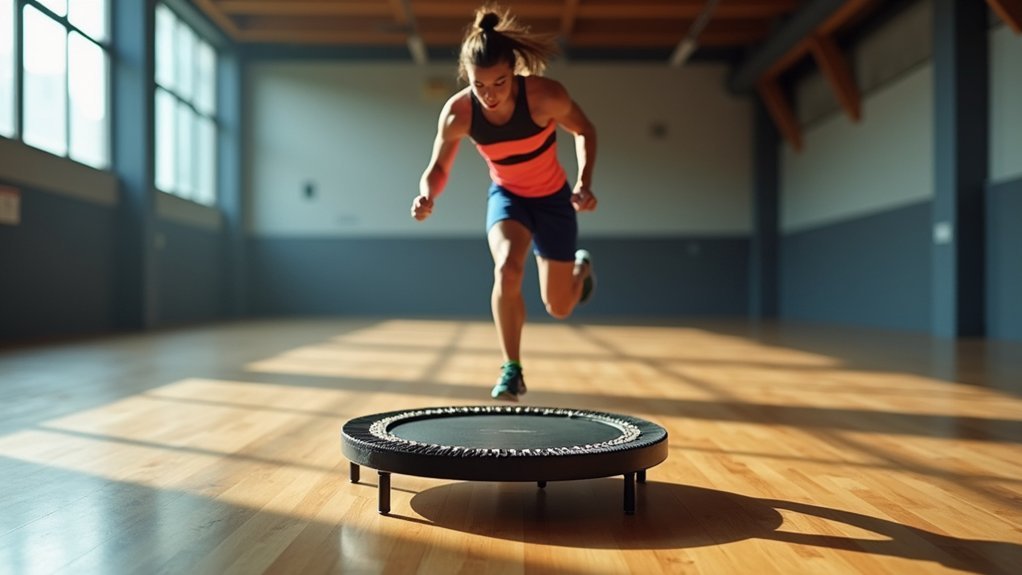Rebounding workouts transform your fitness with remarkable efficiency—just 10 minutes delivers cardiovascular benefits equivalent to 30 minutes of running. You’ll progress from basic health bounces to advanced HIIT protocols that enhance core stability and rotational power. This low-impact, high-reward exercise improves proprioception while burning calories more effectively than traditional cardio. Customize your trampoline training for weight loss, strength, or athletic performance with evidence-based methods that maximize results in minimal time. The science behind these elite challenges reveals why top athletes incorporate rebounding.
The Science Behind Rebounding’s Metabolic Impact

While traditional cardio workouts have long dominated fitness routines, rebounding offers a revolutionary metabolic advantage that’s backed by serious scientific research. NASA studies revealed that just 10 minutes on a rebounder equals 30 minutes of running in cardiovascular benefits—considerably increasing your workout efficiency.
When you bounce, your body achieves remarkable cardiovascular gains with considerably lower metabolic cost. The unique gravitational stimulus created during each bounce strengthens muscles and bones without stressing your joints. Your oxygen consumption is more than twice as efficient compared to treadmill running when G-force stays below 4-G’s.
This means you’re getting superior biomechanical conditioning while your body expends less energy.
The practical benefit? You’ll experience less fatigue, recover faster, and can safely engage in daily rebounding sessions without overtraining. Your muscles and heart work more effectively with reduced energy expenditure.
30-Day Progressive Mini Trampoline Challenge
Despite appearing simple, a structured progressive mini trampoline challenge delivers transformative results within a clear timeframe. Your journey begins with 10-minute sessions at slower tempos, focusing on basic health bounces and proper alignment.
Commit to structured rebounding progression and witness your body transform through consistent, mindful practice.
As you advance, increase both duration and intensity by extending sessions to 21-30 minutes and incorporating faster music with compound movements. Remove your rebounder cover to prevent tripping during lateral exercises, and consider training barefoot to enhance foot strength and body awareness. Maintain proper form during exercises to maximize benefits and prevent potential injuries.
Track your progress through time-based milestones and movement complexity logs. Customize your challenge by blending cardio bursts with strength movements like squats and oblique twists.
For maximum results, join rebounding communities through guided video libraries or specialized apps offering structured daily routines with accountability features.
High-Intensity Interval Rebounding Protocols

You’ll dramatically boost your metabolic rate through targeted Spike Sequencing that alternates 20-second explosive jumps with 10-second recovery periods.
Develop rotational power by incorporating twisting movements that challenge your core stability while maintaining the high-intensity trampoline bounce rhythm. The low impact nature of trampoline workouts reduces strain on joints while still delivering effective cardiovascular benefits.
For maximum calorie burn, combine Tabata-style rope circuits with your rebounding routine—switching rapidly between jump rope patterns and rebounder exercises at 20/10 intervals.
Metabolic Spike Sequencing
When elite athletes incorporate Metabolic Spike Sequencing (MSS) into their jump training, they’re strategically organizing exercises to create powerful metabolic demands across multiple muscle groups.
You’ll maximize your workout efficiency by alternating between upper body, lower body, core, and cardio movements within a 30-40 minute session. This non-competing approach prevents local muscle fatigue while maintaining systemic intensity throughout your workout. Starting with non-competing exercise order ensures optimal strength development during each session.
For best results, vary your time under tension from 20 seconds to 2 minutes per set. Your muscle glycogen serves as primary fuel, with a threshold of 250 mmol/kg dry muscle mass critical for maintaining power output.
Include explosive plyometric jumps to activate fast-twitch fibers and enhance neuromuscular recruitment. This strategic sequencing triggers AMPK pathways, improving glucose uptake, mitochondrial biogenesis, and overall metabolic flexibility.
Rotational Power Development
Harnessing true athletic potential requires mastering rotational power, which forms the foundation of virtually all sport-specific movements. Your body’s kinetic chain must efficiently transfer force from the ground through your hips before reaching your extremities. Coaches should integrate medicine ball throws on dynamic effort days to enhance explosive power development while maintaining speed-strength training intent.
Incorporate these medicine ball throw progressions into your training to maximize rotational explosiveness:
| Position | Drill | Sets | Focus |
|---|---|---|---|
| ½ Kneeling | Rotational Throws | 3×8 | Isolate trunk rotation |
| Bilateral | Parallel Throws | 3×6 | Hip-torso coordination |
| Athletic Stance | Dynamic Throws | 4×5 | Full kinetic chain integration |
| Seated | Isometric-to-Explosive | 3×4 | Force absorption/production |
Remember: power originates from your lower body, not your hands. Create a “lead leg block” while driving your back hip forward to prevent energy leaks and maximize force transfer through your kinetic chain.
Tabata-Style Rope Circuits
To maximize both cardiovascular capacity and explosive power simultaneously, elite athletes turn to Tabata-style rope circuits. This punishing protocol consists of eight rounds of 20-second all-out effort followed by just 10 seconds of rest, creating a brutally effective 4-minute circuit.
You’ll alternate between exercises like freestyle jumps, double unders, and technical moves such as Underhand Figure 8’s and Dragon Rolls.
Try pairing squats with rope flows or combining walking lunges with Overhand Matadors for full-body engagement. Consider implementing a countdown element at the beginning of your session to build anticipation and prepare mentally for the intense work ahead.
Use a timer to maintain precise intervals while focusing on proper technique throughout. For progression, graduate from speed ropes to weighted versions as your capacity improves.
The beauty of this system lies in its efficiency—you’ll achieve greater fat burning and endurance gains in minimal time compared to traditional steady-state cardio.
Core Stabilization Through Dynamic Bouncing

Test your rotational core strength by performing diagonal twists while maintaining tension during bouncing exercises on unstable surfaces.
You’ll activate essential antigravity muscles that resist the downward force when your body rebounds, creating natural resistance that challenges your deep stabilizers.
Your transverse abdominis and multifidus muscles become progressively stronger through these dynamic movements, enhancing total-body stability for improved athletic performance.
The low-impact nature of trampoline workouts protects your joints while still delivering an effective full-body workout experience.
Rotational Tension Testing
Three critical systems work together during rotational tension testing, forming the foundation of elite jumping performance. Your neuromuscular control, core stabilization, and kinetic chain coordination must synchronize to manage rotational forces while maintaining trunk stability during dynamic bouncing.
When you’re executing rotational jumps, your transversus abdominis and internal obliques co-contract to increase intra-abdominal pressure, protecting your spine while allowing powerful movement through the kinetic chain. This protective mechanism creates 360 degrees of stiffness around the spine, essential for both performance enhancement and injury prevention during high-intensity jumping activities.
- Measure rotational power through chop and lift tests, with elite performers generating 277-494 Watts.
- Incorporate Russian twists and med ball throws to develop multi-directional core stability.
- Train deep core muscles first before progressing to global power movements.
- Focus on minimizing asymmetry between dominant and non-dominant sides.
Antigravity Muscle Activation
While many athletes focus exclusively on explosive power, antigravity muscle activation forms the hidden foundation of elite jumping performance.
Your deep core muscles—transversus abdominis, multifidus, and pelvic floor—create a rigid cylinder that stabilizes your spine during dynamic movements.
When you train on bodyweight-supported equipment, you’re challenging these muscles in unique ways. The reduced ground reaction forces allow for increased cadence and flight time while maintaining essential muscle coordination patterns.
To maximize this benefit, incorporate anti-core exercises that resist unwanted movement. Focus on all four categories: anti-extension, anti-rotation, anti-lateral bending, and anti-flexion.
This 360-degree approach guarantees your core can effectively transfer force between your lower and upper body segments, reducing injury risk and optimizing your jumping performance. Developing these muscles through consistent training helps to combat the effects of aging that naturally weaken antigravity muscles over time.
Advanced Proprioception Drills on Unstable Surfaces
Elite athletes seeking to maximize their jumping potential must master advanced proprioception drills on unstable surfaces.
These exercises enhance your body’s position awareness, reducing injury risk while improving performance. By challenging your neuromuscular system on tools like BOSU balls, wobble boards, and foam pads, you’ll develop lightning-quick corrective responses essential for explosive jumping. Muscle spindles and GTOs work together during these exercises to continuously monitor muscle length, tension, and speed of movement, providing critical feedback for stability and control.
- Single-leg pistol squats on a BOSU ball force your ankle and knee proprioceptors to engage constantly.
- Plyometric movements like skater jumps on unstable surfaces develop dynamic stability.
- Try closing your eyes during balance exercises to eliminate visual cues and heighten proprioceptive feedback.
- Combine upper body movements (medicine ball tosses) with unstable stance to train multisensory coordination.
Progress gradually from bilateral to unilateral exercises, increasing difficulty as your proprioceptive abilities improve.
Measuring Heart Rate Zones During Rebound Training
Precise heart rate monitoring forms the backbone of effective rebound training, complementing the proprioceptive work you’ve mastered on unstable surfaces. Understanding your zones maximizes your rebound sessions while preventing overtraining.
For recovery-focused rebound work, aim for Zone 1 (50-60% MHR) or Zone 2 (60-70% MHR), which stimulates blood flow and optimizes aerobic conditioning. Integrate Tempo intervals to enhance this effect. External factors like temperature and altitude can significantly impact your heart rate response during jumping exercises.
When seeking performance gains, periodically push into Zones 3-4 (70-90% MHR) to improve endurance and power.
Pair your jumping exercises with strength components at 80-90% load for nervous system stimulation.
Always finish with a proper cool-down, shifting to low-intensity movement followed by breathing techniques to accelerate recovery and prepare for your next challenge.
Lower-Body Power Development on Mini Trampolines
Beyond conventional platforms, mini trampolines offer exceptional opportunities for developing explosive lower-body power with reduced joint stress.
Your muscles respond differently to the unstable, rebounding surface, engaging fast-twitch fibers critical for power generation while protecting your joints.
Structure your training with 45-50 second work intervals followed by brief 10-15 second rests to maximize power output. Maintaining proper form with core engagement is crucial for maximizing workout efficiency and preventing lower back strain.
Add dumbbells or ankle weights to intensify resistance and further challenge stability.
- Perform plyometric moves like squat jumps and tuck jumps to activate explosive power
- Incorporate single-leg exercises to build unilateral strength and improve balance
- Target your posterior chain with hamstring curls for enhanced propulsion
- Mix lateral movements to strengthen hip stabilizers essential for multi-directional power
Upper Body Integration for Total Rebounding Workouts
While lower-body exercises form the foundation of most rebounding workouts, integrating targeted upper body training transforms trampoline sessions into extensive power-building experiences.
Bent-over rows and chest flys on your rebounder activate 2-3× more muscle fibers than stable-surface equivalents.
Try kneeling curl-presses to isolate biceps and shoulders while the unstable surface forces core engagement. The instability of the trampoline significantly enhances your core activation during these movements. Skull crushers and moving planks leverage the trampoline’s elasticity for increased tricep and shoulder recruitment.
For maximum results, incorporate complex combinations like jumping jacks with overhead presses or lateral raise pulses from a kneeling position.
These movements simultaneously challenge cardiovascular endurance and shoulder stability. Manipulate tempo with slow eccentrics (4s down) during strength movements, and keep rest periods short (15s) to maintain metabolic demand throughout your session.
Mastering Multi-Directional Bounce Patterns
Multi-directional bounce patterns represent the next evolution in rebounding mastery once you’ve integrated upper body training.
Rectangular trampolines offer the most consistent surface for controlling your directional changes while maintaining proper form. You’ll need to engage your core muscles while keeping your upper body stabilized to effectively shift between directions.
For precision in multi-directional rebounding, rectangular surfaces provide stability while core engagement ensures controlled transitions between movements.
To maximize your multi-directional training:
- Focus on centering your body weight before changing directions
- Incorporate arm movements that complement your directional changes
- Use visual cues or spotting techniques to maintain control
- Build leg strength through supplementary exercises like squats
Regular practice with direction-specific drills will enhance your coordination and cardiovascular fitness. Maintaining a solid and flexed body position throughout your movements is essential for controlling your trajectory and preventing injuries.
Remember to always use safety equipment, especially when attempting more advanced combination patterns that involve quick directional shifts.
Recovery Techniques for Intensive Trampoline Sessions
After completing intense trampoline sessions that push your limits, proper recovery becomes just as essential as the workout itself.
Incorporate foam rolling to break down muscle knots and consider manual therapies like cupping to improve tissue mobility.
Don’t underestimate the power of active recovery—10-15 minutes of light bouncing improves lymphatic drainage and reduces inflammation. Boogie Bounce offers an excellent recovery method that supports your body’s natural healing process through lymphatic system stimulation.
Gradually lower your bounce height when ending sessions to safely shift into recovery mode.
Follow up with targeted stretching, focusing on spinal twists and hip mobility to reduce muscle tightness.
Stay well-hydrated to help remove metabolic waste, and prioritize rest periods that allow your muscles to repair and strengthen.
For enhanced recovery, consider specialized tools like electrical muscle stimulation devices that boost blood flow to fatigued areas.
Equipment Selection for Performance-Level Rebounding
When choosing equipment for performance-level rebounding, you’ll need weight-balanced speed ropes that match your training intensity and body mechanics.
The material differences between premium rebounders—from steel frames to specialized spring configurations—directly impact your workout effectiveness and joint protection during high-intensity sessions.
Your selection should prioritize trampolines with commercial-grade components and multiple angle adjustments to maximize both safety and performance adaptability. Consider models with high weight capacity like the BCAN 450/550 Lbs Foldable Mini Trampoline for durability during intense performance training.
Weight-Balanced Speed Ropes
Selecting the right weight-balanced speed rope can transform your elite jump training from ordinary to exceptional. These specialized ropes enhance muscle engagement across your entire body, with resistance that targets both upper and lower body muscles simultaneously.
You’ll experience accelerated muscle growth, improved cardiovascular endurance, and noticeably higher caloric burn compared to standard lightweight ropes.
Weight-balanced ropes also offer training versatility and skill development benefits you can’t get elsewhere:
- Improves proprioception and hand-eye coordination with enhanced feedback
- Makes learning proper timing and rhythm easier with slower rotations
- Allows alternating between different weights to stimulate various muscle fiber types
- Integrates seamlessly into all-encompassing workout routines for total-body conditioning
Studies show weighted ropes significantly strengthen abdominal and back muscles, creating a more stable core for athletic performance.
When performance matters, the right weighted rope becomes your competitive advantage.
Material Performance Differentials
Despite many athletes focusing solely on technique, your equipment’s material composition plays a critical role in achieving elite-level rebounding performance. High-quality rebounders utilize alloy frames and composite materials that optimize energy return while minimizing fatigue.
When selecting your equipment, consider these material differentials:
| Material Type | Performance Impact | Ideal Usage |
|---|---|---|
| Forged Steel Springs | Superior durability, consistent tension | High-intensity interval training |
| Carbon Fiber Frames | Lightweight, maximum energy transfer | Competition-level rebounding |
| Silicone-Composite Mats | Enhanced shock absorption, reduced joint strain | Recovery workouts, rehabilitation |
The right materials dramatically affect your rebound dynamics. Precision-engineered components reduce unwanted “play” while improving energy efficiency. For advanced training, look for adjustable tension mechanisms that allow you to customize resistance based on your specific workout goals and recovery needs. Consider that components built with stronger materials significantly reduce the risk of breakage during intense workouts, similar to high-performance differential parts.
Tracking Progress: Metrics That Matter for Rebounders
To maximize your rebounder workout results, you’ll need to track specific metrics that indicate true progress. Your body weight directly impacts calorie burn—heavier individuals typically burn more during identical sessions. This was confirmed in the study where Alex, at 208 pounds, burned significantly more calories than Sydney at 128 pounds during the same workouts.
Heart rate monitoring provides immediate feedback on workout intensity, while tracking duration helps optimize your training schedule.
Apps like Bounce Tracker can revolutionize your rebounding experience by recording essential data:
- Calories burned during different intensity levels
- Bounce count and rhythm consistency
- Heart rate variability throughout workouts
- Session duration and recovery intervals
Remember to monitor physical metrics including muscle composition and weight changes.
Athletic Crossover Benefits From Trampoline Training
Your trampoline workouts will enhance sport-specific movement patterns by building neural pathways that transfer directly to your athletic performance.
You’ll develop superior reactive strength as the rebound surface trains your muscles to quickly absorb and generate force, a critical skill in virtually all competitive sports.
Regular trampoline sessions can also optimize your recovery cycles between intense training days, allowing you to maintain high-level performance while reducing injury risk. The Olympic recognition of trampoline jumping validates its effectiveness as a legitimate training method for serious athletes.
Sport-Specific Movement Patterns
While many athletes focus solely on conventional training methods, trampoline workouts offer unique crossover benefits that directly enhance sport-specific movement patterns.
Your body learns to adapt to unstable surfaces, reinforcing the exact movements you need for your sport.
Trampolines simulate critical athletic actions, helping you master proper form while improving neuromuscular coordination.
You’ll develop better proprioception—your body’s ability to sense position and movement—which translates directly to superior performance. The unstable surface significantly heightens neuromuscular awareness for identifying and correcting movement deficiencies.
- Improved landing mechanics for gymnastics, volleyball, and basketball
- Enhanced power generation for jumps, vaults, and explosive movements
- Better dynamic balance during rapid directional changes
- Refined trunk control for sport-specific techniques
These benefits create a direct transfer to your athletic performance, making trampolines an invaluable addition to sport-specific training regimens.
Reactive Strength Development
Three critical components of reactive strength can be greatly enhanced through strategic trampoline training. Your body’s stretch-shortening cycle (SSC) improves markedly on the elastic surface, optimizing your ability to shift quickly between eccentric and concentric muscle contractions—the foundation of explosive power.
You’ll develop higher Reactive Strength Index (RSI) scores through trampoline work, as research shows the unstable surface engages multiple muscle groups simultaneously. This translates directly to improved performance in fast SSC activities like sprinting and jumping. Regular monitoring of these activities can help prevent neuromuscular fatigue and optimize training readiness.
Unlike traditional plyometrics, trampoline training offers scalable intensity with lower injury risk while still stimulating bone density improvements.
Elite trampoline athletes demonstrate exceptional jump-to-jump stability and minimal performance decrements during repeated efforts—qualities you’ll develop through consistent training that carries over to virtually all explosive sports.
Recovery Cycle Enhancement
Athletes seeking thorough recovery protocols can leverage trampoline training for ideal post-workout regeneration.
Your body benefits from the trampoline’s unique low-impact surface, which reduces joint stress by up to 80% while still providing active recovery benefits.
You’ll accelerate your recovery cycle through improved lymphatic circulation, helping flush toxins and reduce muscle soreness faster than passive recovery methods.
The gentle rebounding motion enhances proprioception and restores neuromuscular balance without overtaxing healing tissues. This approach mirrors the benefits seen in stroke patients who showed significant improvements in balance and mobility after just six weeks of trampoline training.
- Stimulates lymphatic flow for enhanced detoxification
- Provides cardiovascular benefits without joint stress
- Releases mood-boosting endorphins to combat recovery fatigue
- Maintains muscle engagement while allowing cellular repair
Incorporate 10-15 minutes of gentle rebounding between intense training sessions to maintain fitness momentum while giving your body the regenerative pause it needs.
Customizing Rebound Workouts for Specific Fitness Goals
Whether you’re aiming to shed pounds, build strength, improve joint health, or enhance athletic performance, rebound workouts offer exceptional versatility for tailoring exercises to your unique fitness goals.
For weight loss, try 10-minute HIIT sessions multiple times daily, alternating between high and low-intensity movements to maximize calorie burn without joint strain. Rebounding allows you to exercise for longer periods without pain, making it ideal for consistent weight loss routines.
If you’re a beginner, start with simple marches or gentle bounces, possibly using a stability bar for balance. As you advance, incorporate jumping jacks, high knees, and mountain climbers.
Those with joint concerns will appreciate rebounding’s low-impact nature that still stimulates bone density and enhances stability.
For athletic conditioning, explore movements across multiple planes that traditional cardio machines don’t offer, improving overall athleticism while maintaining lower impact on your body.
Frequently Asked Questions
Can Jump Workouts Help Correct Muscle Imbalances?
Yes, jump workouts can correct muscle imbalances by revealing weaknesses through single-leg exercises, improving strength symmetry, and enhancing neuromuscular coordination. You’ll benefit most when you combine them with targeted mobility and stability training.
Is Skipping Rope Safe for Those With Mild Knee Problems?
Yes, you can safely skip rope with mild knee issues if you use proper form, land softly, wear supportive shoes, and jump on cushioned surfaces. Start with short sessions and stop if you experience pain.
How Do Weighted Jump Ropes Affect Calorie Burn Versus Standard Ropes?
Weighted jump ropes burn more calories than standard ropes—roughly 13.6 vs. 12.8-13.3 calories per minute. You’ll engage more muscles with the added resistance, potentially doubling your caloric burn during your workout.
Can Rebounding Exercises Improve Lymphatic System Function?
Yes, rebounding exercises greatly improve your lymphatic system function. When you bounce, you’ll create gravitational changes that activate one-way valves in your lymphatic vessels, enhancing circulation and toxin removal throughout your body.
What Flooring Provides Optimal Shock Absorption for Jump Training?
For ideal shock absorption during jump training, you’ll find high-density rubber flooring (1/2 inch thick) best protects your joints. Thicker rubber tiles (2 inches) offer superior cushioning if you’re doing high-impact plyometrics.
In Summary
You’ve now got all the tools to transform your fitness journey through rebounding. By incorporating these progressive challenges, interval protocols, and specialized drills, you’ll boost metabolism, core strength, and athletic performance. Remember to track your metrics and choose proper equipment as you advance. Whether you’re a beginner or elite athlete, customize these trampoline workouts to your specific goals and watch your fitness literally soar to new heights.





Leave a Reply